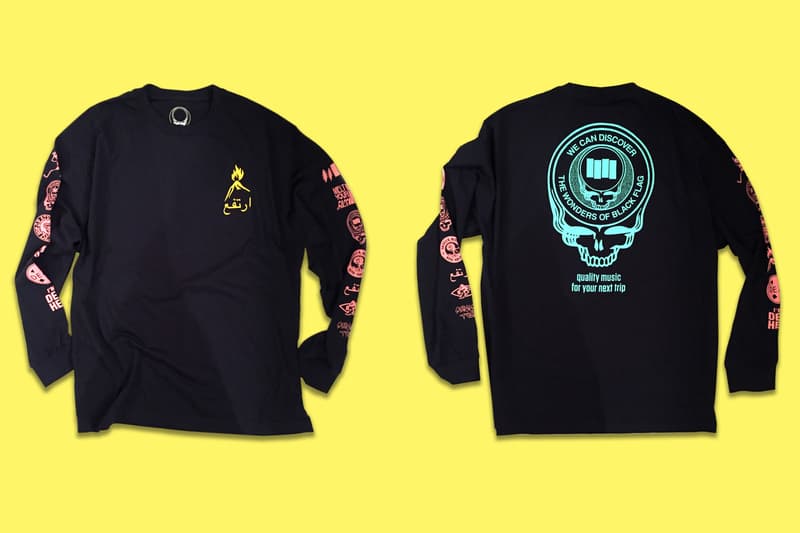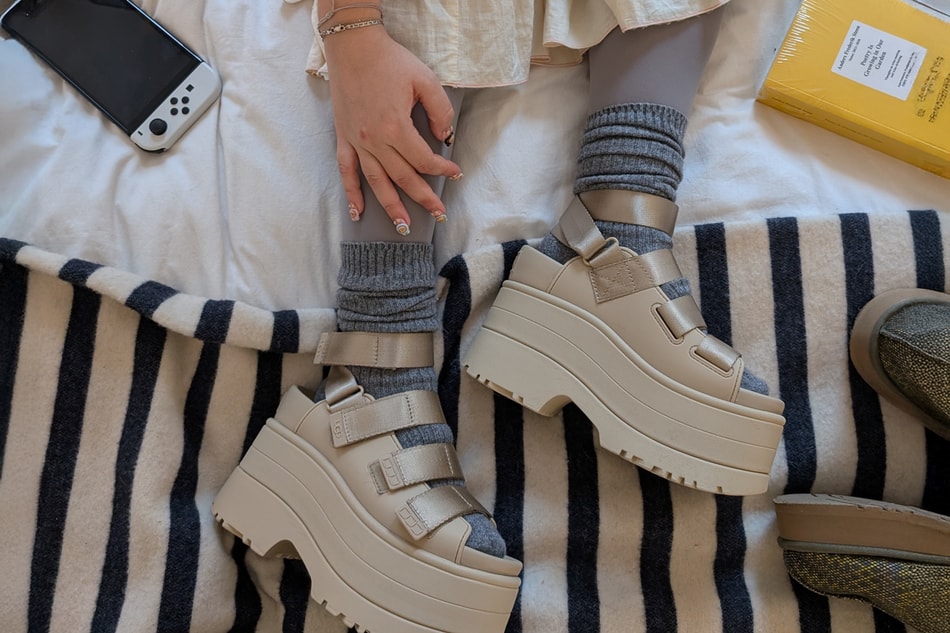The Untold Truth Behind Bootleg Merch
Before The Life of Pablo was The Grateful Dead.
Kanye West’s first The Life of Pablo New York pop-up was a moment that echoed the current state of streetwear—it had the hype, long lines, and the scammer-DIY feel that comes with selling screen-printed Gildan T-shirts for $45. Truly capturing the moment though were two kids, Austin Butts and Jonah Levine, who took it upon themselves to print and sell bootleg Pablo merch to those waiting in line. Though the pair treated the venture as more of a joke than a real business opportunity, their side hustle was a remarkably current move that highlighted the absurdity of a bootleg-obsessed world where Balenciaga can rip an IKEA bag and Gucci can sell reappropriated bootleg tees for $500+. But Kanye fans aren’t the only ones putting their own spin on official tour merch; for decades now, Deadheads, or fans of the Grateful Dead, have been perfecting the art of the bootleg tee.
Though the stereotypical stoner uncle Deadhead might seem several cultural light years away from the young, streetwear-savvy Kanye fan, Grateful Dead bootlegs have recently carved out an ever-growing niche in the streetwear world. Some of the credit for this unexpected convergence can be given to John Mayer, everyone’s favorite visvim-collecting pop-rock star. In addition to his solo work, Mayer has been touring with Grateful Dead reboot Dead & Company, acting as a conduit between hypebeast and Deadhead cultures, and along the way collaborating with designers and archivists that are doing their part to bring the Deadhead bootleg culture into 2017.
But even with the “Mayer-effect,” it’s admittedly a bit bizarre for a jam band that broke up in 1995 to suddenly become relevant in 2017 streetwear culture (unless you’re Wes Lang, who was designing Grateful Dead merch decades before he created his famous Yeezus tour imagery). However, given streetwear’s current obsession with bootlegs and tour merch, it might not be such a surprise that bootlegs sporting skeletons and roses, known affectionately by Deadheads as Bertha, and the famous “lightning skull”–both iconic Grateful Dead imagery–are making their way into the fashion world.
Bootleg merch has been a key part of Deadhead culture since the group’s early touring years. From the ‘70s up to the band’s end in ‘95, venue parking lots and surrounding streets gave home to a community of vendors. Known by Deadheads as “Shakedown Street” (after the Grateful Dead song of the same name), these were mobile bazaars where enterprising concert-goers sold and traded everything under the sun, from snacks to ‘shrooms, to what are now much sought-after bootleg Grateful Dead tour T-shirts.
Elisa Seltzer, a longtime Dead fan who attended shows in Illinois and Michigan as far back as the late ‘70s and ’80s, recalled the scene outside a show. “What would be pretty typical,” she remembers of a Shakedown Street, “is someone might have one of those old olive green rucksacks and they’d have T-shirts… hanging from the backpacks, and maybe different styles hanging off different sides.” If a ‘head saw something they liked, the seller would grab their size and sell them the hand-designed shirt for cheaper than they could find in the venue.
“I don’t think bootleg culture or T-shirt culture existed then.”
Scenes like these have defined what is now a near-half century-long history of bootleg merch. It’s a history that Mason Warner, with his blog and Instagram account, From the Lot, has taken upon himself to record. With From the Lot, Warner documents the Grateful Dead’s history through the lens of the bootleg “Lot T-shirt” (referring to the parking lot outside of a concert), posting photos of shirts and occasionally other merch that tells the band’s story. “I’ve seen T-shirts from the late ’60s and early ’70s that were fan-made,” he mentions, referring to just how far back Grateful Dead bootleg cultures goes. “I don’t think bootleg culture or T-shirt culture existed then but I’ve seen stuff that’s way more clever than anything that’s come from [the band’s official merch].”
He compares the bootleg lot tee to another popular bootleg tee phenomenon: Bootleg Barts, which were bootleg Bart Simpson T-shirts that were popular during the show’s heyday in the ‘90s-’00s. “At the time in the early ’90s you had Bootleg Bart at places like [hip-hop and streetwear culture landmark] Compton Swap Meet, but at the same time you literally had that shit at Grateful Dead parking lots.”
Not just an archivist, Warner is part of an active group of Deadheads that produces modern takes on the Grateful Dead bootleg. These designers are creating ever more sought-after shirts that maintain the spirit of the original bootlegs that defined so much of Grateful Dead fandom, but with references to pop culture that are more relevant to today’s streetwear consumer. A fixture of this new scene is designer and decades-long friend (and collaborator) of Warner, Jeremy Dean, better known as @deansnuts on Instagram.
Dean, whose designs have caught the attention and collaborative efforts of John Mayer, has never considered his shirts to be strictly Dead bootlegs. Rather, his designs, many of which he releases through what he loosely refers to as “DES” (an acronym which could stand for “Double Edged Sword,” but which he chooses to keep as nebulous as possible), are often a blend of Grateful Dead and Black Flag imagery. Though the combination of imagery from a jam band and a hardcore punk band certainly seem disjointed on the surface, Dean points out that Greg Ginn, frontman of Black Flag, was a huge fan of the Grateful Dead. “The whole reason [these T-shirts] happened is that I was fascinated that Greg Ginn absolutely loves the Grateful Dead,” Dean mentions, also bringing up the fact that he noticed many of his friends in the ’80s hardcore scene go on to become Grateful Dead fans.
Though the combined imagery of the two bands might at first be a bit jarring, he credits it as one of the main reasons his tees have found success among younger audiences today. “It’s that mix of things,” he relates, “it hits all of the notes of: this is two familiar symbols, put in a funny context, which can be a weird safe space for people who might like the iconography of the Dead but might not be fully into them to bridge that gap [into wearing a shirt].”
Warner agrees that the expanded set of references is a key reason that images like the “Steal Your Face” lightning skull are becoming more common in younger crowds: “Back when I was going to shows there wasn’t the influence of pop culture, or punk rock, or skateboarding, or even hip-hop for that matter. Now you have kids who are growing up in those scenes and starting to mix that into the design language… You take a Grateful Dead skeleton with a punk rock influence and mix in some hip-hop and skateboarding, sign me up all day.” History and pop culture references aside, it’s hard to ignore the typical reaction to seeing such seemingly random iconic imagery side-by-side on a T-shirt; sure, Dean’s shirts are well-designed with a meaningful history, but like many bootlegs that have come before, they’re still just fun.
“Gucci said fuck it, let’s just capitalize on this.”
While a rich history and a set of active designers creating great shirts deserve much of the credit, the Grateful Dead knockoff’s recent spike in popularity is undoubtedly tied to fashion’s current obsession with bootlegs. It’s a trend that both Dean and Warner, who have both have a long history in the streetwear world–Dean can describe the Supreme store before there were lines outside of it and Warner used to own a sneaker store in Philadelphia–have taken note of. “It’s a good time again for this world [of bootlegs],” Dean mentions, adding that he’s noticed a recent “injection of bootleg culture into the streetwear world.”
Of course, bootlegs have been a recurring theme in streetwear–just look at Dapper Dan’s famous appropriations of logos from luxury brands like Louis Vuitton and Gucci. But the frenzy around Kanye’s Life of Pablo merch was just the beginning of this recent upswing in bootlegs. Now, with the same luxury brands that Dapper Dan reworked beginning to throw their support behind the trend, it’s becoming difficult to overstate just how relevant bootleg culture has become in the fashion industry at large. Though the gradual convergence of “capital F Fashion” and streetwear may be an idea that’s been talked to death as of late, one can’t ignore the fashion industry’s own appropriation of the classically “streetwear” bootleg as one of the central reasons why a Supreme x Louis Vuitton collaboration now doesn’t seem nearly as bizarre as it would have even a couple years ago.
“Look at what Gucci has done in the last couple years,” Warner adds while discussing the prevalence of bootleg culture. “The bootleg swap meet Gucci shirts started flipping on eBay for $200-$300, so Gucci said ‘fuck it, let’s just capitalize on this.’” Meanwhile, you have brands like Supreme growing what began 17 years ago as a cease and desist-earning skate deck into an industry-changing official collaboration, while Demna Gvasalia has turned Vetements into a household name (and has arguably started off this whole “high fashion bootleg trend) with his infamous DHL bootleg. Anyone selling bootleg tees in 2017, whether it’s vintage ‘70s lot tees or Gucci shirts straight off the rack, will admit that the pump is primed and business is good.
Indeed, with the reemergence of the bootleg tee, 2017 has been the perfect storm for the Grateful Dead’s rise to popularity. Besides falling neatly into one of the year’s most inescapable trends, the Grateful Dead’s imagery like the “Steal Your Face” lightning skull is just so cool; it’s instantly recognizable and maintains the unique ability to conjure up an entire subculture and its history. Meanwhile, with individuals like Mayer, Warner and Dean doing their part to contextualize the Dead’s bootleg-heavy history within pop culture at large, we can expect much more Bertha to come.








